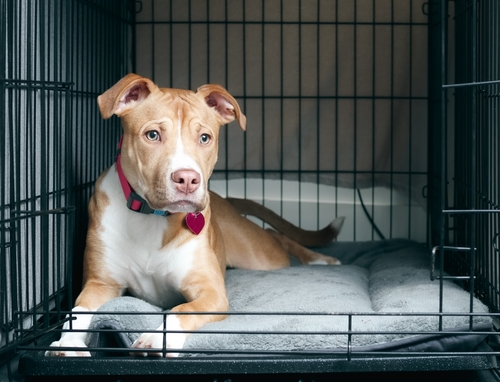Tips for Crate Training Your Puppy At Night

Crate training is an effective method for housebreaking and establishing routine with your new puppy. Not only does it provide them with a safe and comfortable space, but it also helps prevent accidents and destructive behavior during the night. However, introducing crate training to your puppy can sometimes be challenging, especially at night when they may feel anxious or lonely. In this blog post, we will explore some tips to help you successfully crate train your puppy at night.
1. Choose the Right Crate:
The first step in crate training your puppy at night is selecting an appropriate crate. Ensure that the crate is large enough for your puppy to stand up, turn around, and lie down comfortably. However, it should not be too large that they can use one side as a bathroom area. Opt for a crate with a secure and sturdy construction to prevent any escape attempts. Additionally, consider placing soft bedding or a familiar item with your scent in the crate to make it more inviting and comforting for your puppy.
2. Gradually Introduce Your Puppy to the Crate:
It is essential to introduce the crate slowly to your puppy and create positive associations with it. Start by placing treats or their favorite toys near the crate to encourage exploration. As they become more comfortable, place treats inside the crate, allowing them to enter on their own. Avoid forcing your puppy into the crate, as this can create a negative association with it. Gradually build up their time spent in the crate, initially starting with short periods, and gradually increasing the duration.
3. Make the Crate a Positive and Comfortable Space:
To help your puppy adjust to the crate at night, make it a positive and comfortable space. Place the crate in an area where your puppy can still see and hear you, such as your bedroom. This helps alleviate any anxiety or loneliness they may experience during the night. Use soft bedding or a crate pad to make it cozy and inviting. Consider covering the crate with a light blanket to create a den-like environment, providing a sense of security for your puppy.
4. Establish a Bedtime Routine:
Establishing a bedtime routine for your puppy can help facilitate the crate training process. Dogs are creatures of habit, and a consistent routine can provide them with a sense of security. Create a routine that involves a specific time for taking your puppy out for a bathroom break, followed by some playtime or a calming activity before bedtime. By incorporating the crate into this routine, your puppy will begin to associate it with relaxation and sleep.
5. Use Positive Reinforcement:
Positive reinforcement is a powerful tool when crate training your puppy at night. Reward your puppy with praise, treats, or a favorite toy when they willingly enter and settle in the crate. Make sure to provide positive reinforcement immediately after they exhibit the desired behavior, reinforcing the connection between their actions and the rewards. This positive association will encourage your puppy to view the crate as a positive and comfortable space.
6. Address Whining or Anxiety:
It is common for puppies to experience some level of anxiety or whining during the initial stages of crate training at night. This is their way of expressing their discomfort or needing attention. It is important not to give in to their demands or let them out of the crate when they whine, as it can reinforce the behavior. Instead, try redirecting their attention by offering a soothing toy or a stuffed Kong filled with treats. Be patient and consistent, as puppies typically adjust to the crate over time.
7. Be Patient and Consistent:
Like any training process, crate training your puppy at night requires patience and consistency. It may take time for your puppy to adjust and feel comfortable in the crate during the night. Stay consistent with the routine, reward positive behaviors, and refrain from letting your puppy out of the crate when they whine or bark. With time and consistent training, your puppy will learn to associate the crate with security and restful sleep.
Summary
Crate training your puppy at night can be a beneficial process for both you and your furry friend. By selecting the right crate, gradually introducing your puppy to it, making the crate a positive space, establishing a bedtime routine, using positive reinforcement, addressing any whining or anxiety, and maintaining patience and consistency, you can successfully crate train your puppy at night. Remember, the key to successful crate training is to create a safe and comfortable space that promotes a sense of security and routine for your puppy.
Need Dog Services in Bee Cave, TX?
At Just Four Paws, Inc., we understand that your furry friends are more than just pets – they are cherished members of your family. That’s why we are committed to providing the best possible care for them during their stay with us. Our pet boarding services offer a safe and comfortable environment where your pets will receive individual attention and plenty of playtime. Additionally, our expert groomers are dedicated to pampering your pets and ensuring they look and feel their best. Trust Just Four Paws, Inc. with your pets’ needs and give them the love and care they deserve. Contact us today to learn more about what we can do for you!
